Mental Health Consequences of Child Abuse: A Research Report
VerifiedAdded on 2023/01/12
|9
|2740
|76
Report
AI Summary
This report investigates the profound impact of child abuse on the mental health of young individuals, drawing on both qualitative and quantitative research methodologies. The study examines the effects of various forms of child maltreatment, including physical abuse, emotional abuse, neglect, and exposure to domestic violence, on the psychological well-being of children. Qualitative studies explore caregiver experiences, interventions, and the impact of child sexual abuse discovery on families, while quantitative studies employ systematic reviews and meta-analyses to assess the long-term health consequences and prevalence of child abuse. The report highlights the importance of understanding the complex interplay between child abuse and mental health outcomes, emphasizing the need for effective interventions, including training programs for professionals, positive discipline therapy, and systemic approaches to reduce child abuse and domestic violence. The research underscores the severe and lasting effects of child maltreatment, including psychological dysfunction, and its impact on education and life outcomes, advocating for increased awareness and protective measures.
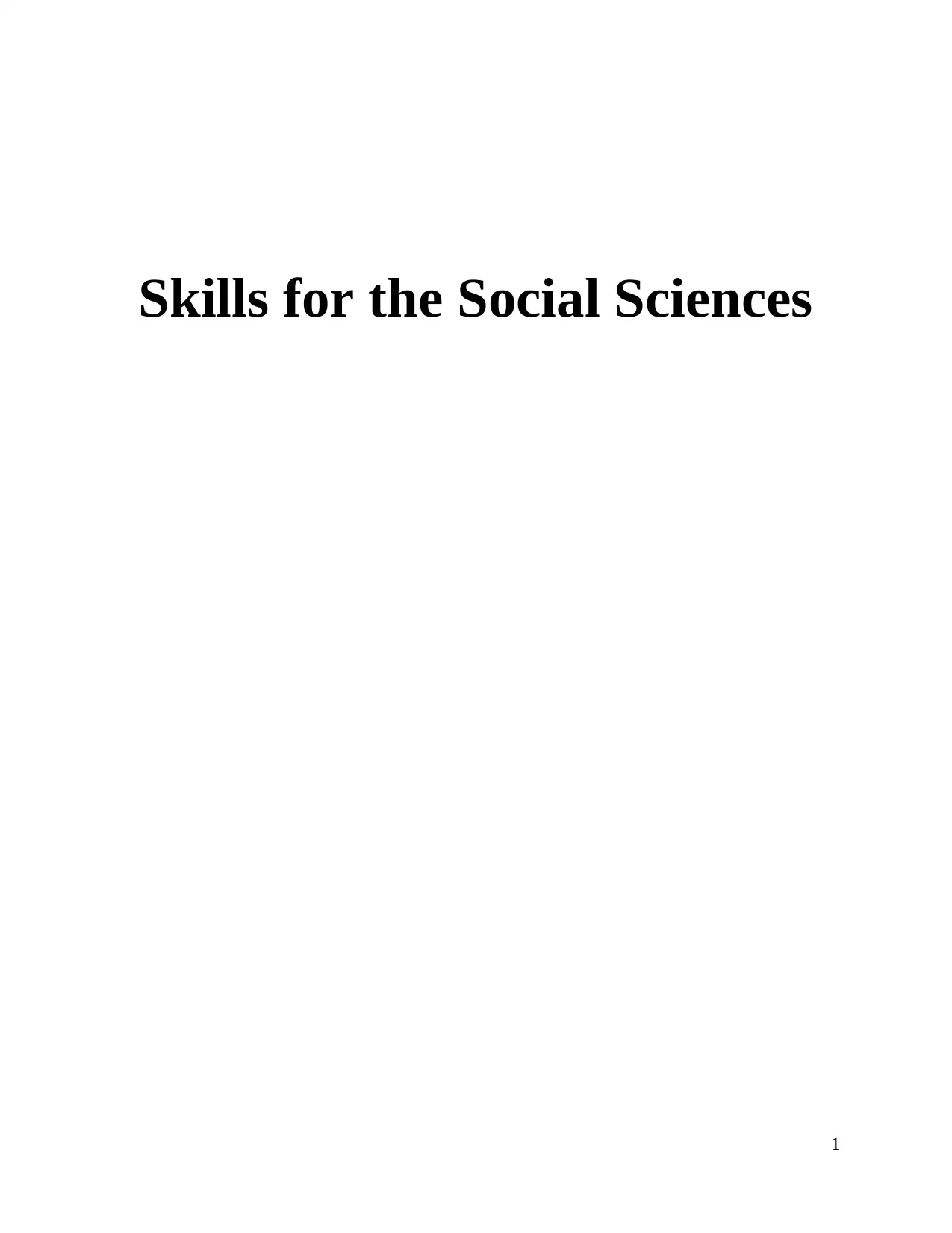
Skills for the Social Sciences
1
1
Paraphrase This Document
Need a fresh take? Get an instant paraphrase of this document with our AI Paraphraser
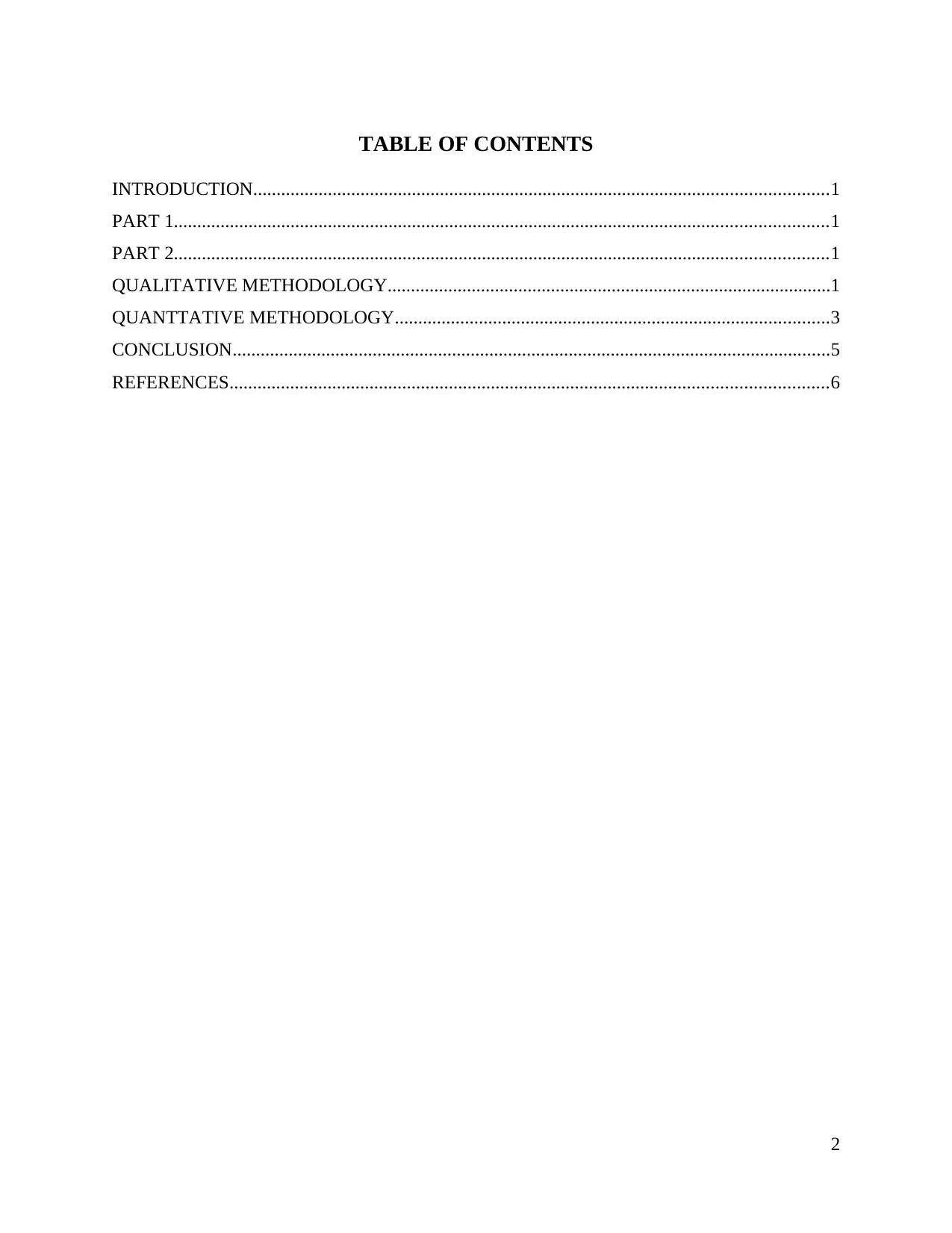
TABLE OF CONTENTS
INTRODUCTION...........................................................................................................................1
PART 1............................................................................................................................................1
PART 2............................................................................................................................................1
QUALITATIVE METHODOLOGY...............................................................................................1
QUANTTATIVE METHODOLOGY.............................................................................................3
CONCLUSION................................................................................................................................5
REFERENCES................................................................................................................................6
2
INTRODUCTION...........................................................................................................................1
PART 1............................................................................................................................................1
PART 2............................................................................................................................................1
QUALITATIVE METHODOLOGY...............................................................................................1
QUANTTATIVE METHODOLOGY.............................................................................................3
CONCLUSION................................................................................................................................5
REFERENCES................................................................................................................................6
2
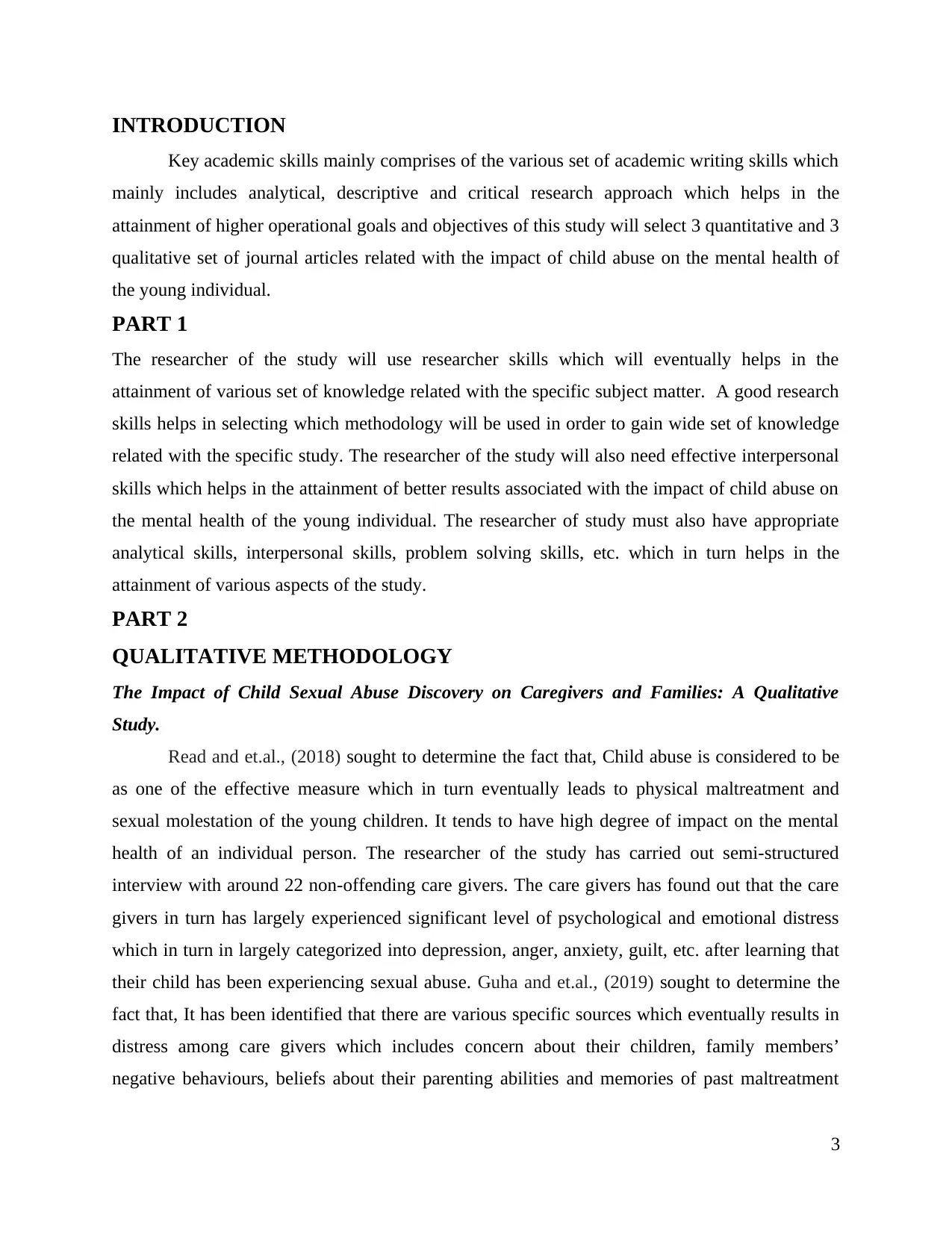
INTRODUCTION
Key academic skills mainly comprises of the various set of academic writing skills which
mainly includes analytical, descriptive and critical research approach which helps in the
attainment of higher operational goals and objectives of this study will select 3 quantitative and 3
qualitative set of journal articles related with the impact of child abuse on the mental health of
the young individual.
PART 1
The researcher of the study will use researcher skills which will eventually helps in the
attainment of various set of knowledge related with the specific subject matter. A good research
skills helps in selecting which methodology will be used in order to gain wide set of knowledge
related with the specific study. The researcher of the study will also need effective interpersonal
skills which helps in the attainment of better results associated with the impact of child abuse on
the mental health of the young individual. The researcher of study must also have appropriate
analytical skills, interpersonal skills, problem solving skills, etc. which in turn helps in the
attainment of various aspects of the study.
PART 2
QUALITATIVE METHODOLOGY
The Impact of Child Sexual Abuse Discovery on Caregivers and Families: A Qualitative
Study.
Read and et.al., (2018) sought to determine the fact that, Child abuse is considered to be
as one of the effective measure which in turn eventually leads to physical maltreatment and
sexual molestation of the young children. It tends to have high degree of impact on the mental
health of an individual person. The researcher of the study has carried out semi-structured
interview with around 22 non-offending care givers. The care givers has found out that the care
givers in turn has largely experienced significant level of psychological and emotional distress
which in turn in largely categorized into depression, anger, anxiety, guilt, etc. after learning that
their child has been experiencing sexual abuse. Guha and et.al., (2019) sought to determine the
fact that, It has been identified that there are various specific sources which eventually results in
distress among care givers which includes concern about their children, family members’
negative behaviours, beliefs about their parenting abilities and memories of past maltreatment
3
Key academic skills mainly comprises of the various set of academic writing skills which
mainly includes analytical, descriptive and critical research approach which helps in the
attainment of higher operational goals and objectives of this study will select 3 quantitative and 3
qualitative set of journal articles related with the impact of child abuse on the mental health of
the young individual.
PART 1
The researcher of the study will use researcher skills which will eventually helps in the
attainment of various set of knowledge related with the specific subject matter. A good research
skills helps in selecting which methodology will be used in order to gain wide set of knowledge
related with the specific study. The researcher of the study will also need effective interpersonal
skills which helps in the attainment of better results associated with the impact of child abuse on
the mental health of the young individual. The researcher of study must also have appropriate
analytical skills, interpersonal skills, problem solving skills, etc. which in turn helps in the
attainment of various aspects of the study.
PART 2
QUALITATIVE METHODOLOGY
The Impact of Child Sexual Abuse Discovery on Caregivers and Families: A Qualitative
Study.
Read and et.al., (2018) sought to determine the fact that, Child abuse is considered to be
as one of the effective measure which in turn eventually leads to physical maltreatment and
sexual molestation of the young children. It tends to have high degree of impact on the mental
health of an individual person. The researcher of the study has carried out semi-structured
interview with around 22 non-offending care givers. The care givers has found out that the care
givers in turn has largely experienced significant level of psychological and emotional distress
which in turn in largely categorized into depression, anger, anxiety, guilt, etc. after learning that
their child has been experiencing sexual abuse. Guha and et.al., (2019) sought to determine the
fact that, It has been identified that there are various specific sources which eventually results in
distress among care givers which includes concern about their children, family members’
negative behaviours, beliefs about their parenting abilities and memories of past maltreatment
3
⊘ This is a preview!⊘
Do you want full access?
Subscribe today to unlock all pages.

Trusted by 1+ million students worldwide
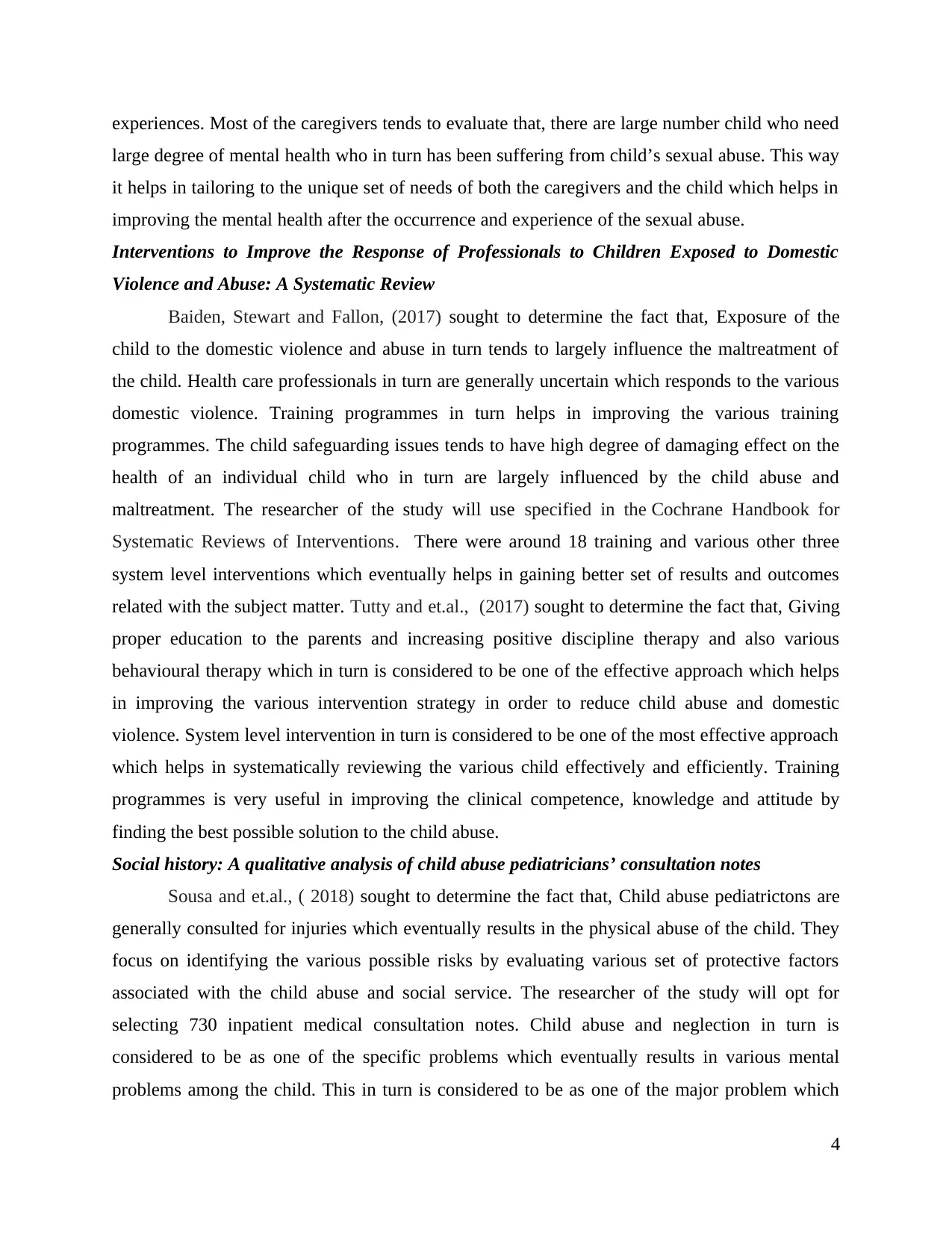
experiences. Most of the caregivers tends to evaluate that, there are large number child who need
large degree of mental health who in turn has been suffering from child’s sexual abuse. This way
it helps in tailoring to the unique set of needs of both the caregivers and the child which helps in
improving the mental health after the occurrence and experience of the sexual abuse.
Interventions to Improve the Response of Professionals to Children Exposed to Domestic
Violence and Abuse: A Systematic Review
Baiden, Stewart and Fallon, (2017) sought to determine the fact that, Exposure of the
child to the domestic violence and abuse in turn tends to largely influence the maltreatment of
the child. Health care professionals in turn are generally uncertain which responds to the various
domestic violence. Training programmes in turn helps in improving the various training
programmes. The child safeguarding issues tends to have high degree of damaging effect on the
health of an individual child who in turn are largely influenced by the child abuse and
maltreatment. The researcher of the study will use specified in the Cochrane Handbook for
Systematic Reviews of Interventions. There were around 18 training and various other three
system level interventions which eventually helps in gaining better set of results and outcomes
related with the subject matter. Tutty and et.al., (2017) sought to determine the fact that, Giving
proper education to the parents and increasing positive discipline therapy and also various
behavioural therapy which in turn is considered to be one of the effective approach which helps
in improving the various intervention strategy in order to reduce child abuse and domestic
violence. System level intervention in turn is considered to be one of the most effective approach
which helps in systematically reviewing the various child effectively and efficiently. Training
programmes is very useful in improving the clinical competence, knowledge and attitude by
finding the best possible solution to the child abuse.
Social history: A qualitative analysis of child abuse pediatricians’ consultation notes
Sousa and et.al., ( 2018) sought to determine the fact that, Child abuse pediatrictons are
generally consulted for injuries which eventually results in the physical abuse of the child. They
focus on identifying the various possible risks by evaluating various set of protective factors
associated with the child abuse and social service. The researcher of the study will opt for
selecting 730 inpatient medical consultation notes. Child abuse and neglection in turn is
considered to be as one of the specific problems which eventually results in various mental
problems among the child. This in turn is considered to be as one of the major problem which
4
large degree of mental health who in turn has been suffering from child’s sexual abuse. This way
it helps in tailoring to the unique set of needs of both the caregivers and the child which helps in
improving the mental health after the occurrence and experience of the sexual abuse.
Interventions to Improve the Response of Professionals to Children Exposed to Domestic
Violence and Abuse: A Systematic Review
Baiden, Stewart and Fallon, (2017) sought to determine the fact that, Exposure of the
child to the domestic violence and abuse in turn tends to largely influence the maltreatment of
the child. Health care professionals in turn are generally uncertain which responds to the various
domestic violence. Training programmes in turn helps in improving the various training
programmes. The child safeguarding issues tends to have high degree of damaging effect on the
health of an individual child who in turn are largely influenced by the child abuse and
maltreatment. The researcher of the study will use specified in the Cochrane Handbook for
Systematic Reviews of Interventions. There were around 18 training and various other three
system level interventions which eventually helps in gaining better set of results and outcomes
related with the subject matter. Tutty and et.al., (2017) sought to determine the fact that, Giving
proper education to the parents and increasing positive discipline therapy and also various
behavioural therapy which in turn is considered to be one of the effective approach which helps
in improving the various intervention strategy in order to reduce child abuse and domestic
violence. System level intervention in turn is considered to be one of the most effective approach
which helps in systematically reviewing the various child effectively and efficiently. Training
programmes is very useful in improving the clinical competence, knowledge and attitude by
finding the best possible solution to the child abuse.
Social history: A qualitative analysis of child abuse pediatricians’ consultation notes
Sousa and et.al., ( 2018) sought to determine the fact that, Child abuse pediatrictons are
generally consulted for injuries which eventually results in the physical abuse of the child. They
focus on identifying the various possible risks by evaluating various set of protective factors
associated with the child abuse and social service. The researcher of the study will opt for
selecting 730 inpatient medical consultation notes. Child abuse and neglection in turn is
considered to be as one of the specific problems which eventually results in various mental
problems among the child. This in turn is considered to be as one of the major problem which
4
Paraphrase This Document
Need a fresh take? Get an instant paraphrase of this document with our AI Paraphraser
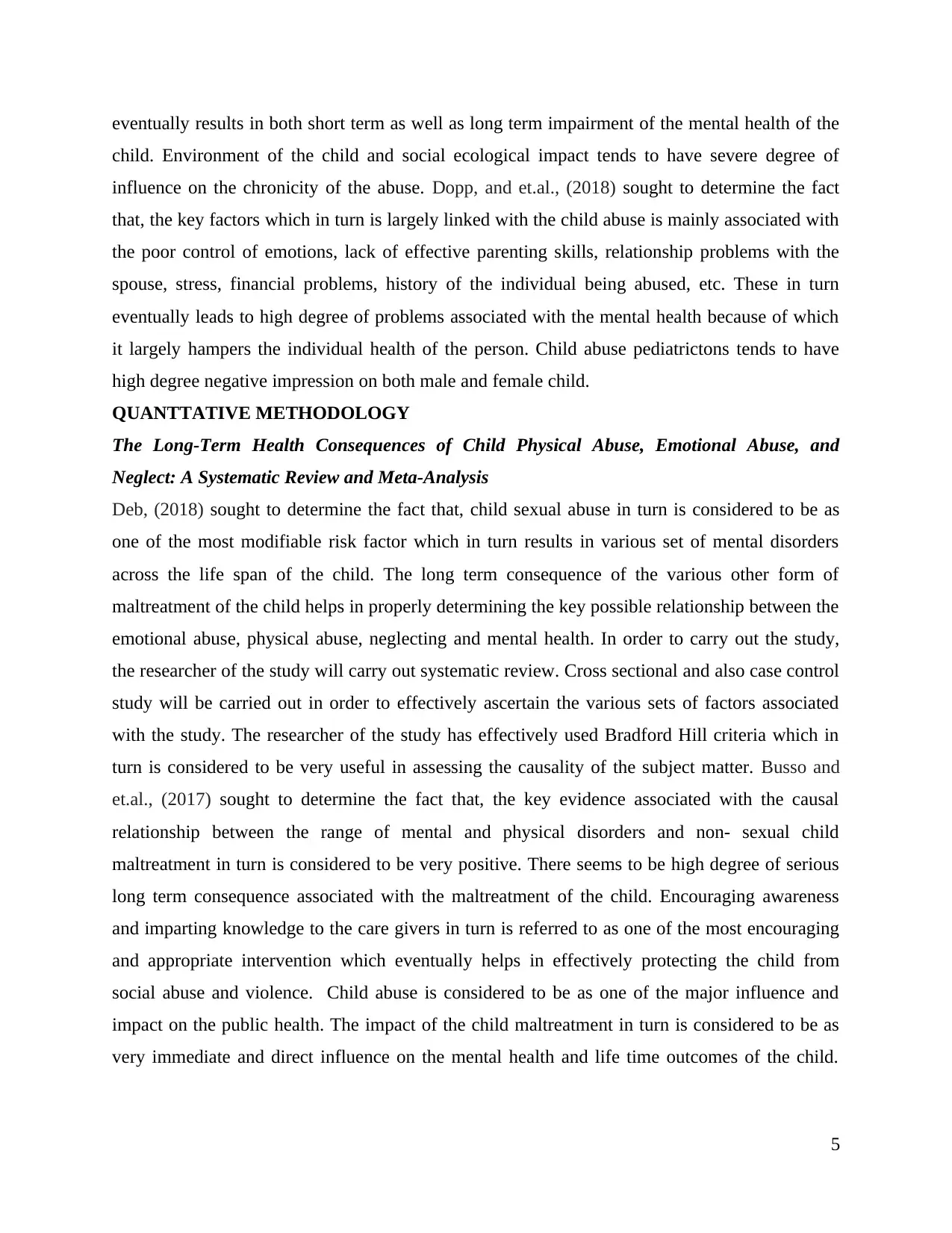
eventually results in both short term as well as long term impairment of the mental health of the
child. Environment of the child and social ecological impact tends to have severe degree of
influence on the chronicity of the abuse. Dopp, and et.al., (2018) sought to determine the fact
that, the key factors which in turn is largely linked with the child abuse is mainly associated with
the poor control of emotions, lack of effective parenting skills, relationship problems with the
spouse, stress, financial problems, history of the individual being abused, etc. These in turn
eventually leads to high degree of problems associated with the mental health because of which
it largely hampers the individual health of the person. Child abuse pediatrictons tends to have
high degree negative impression on both male and female child.
QUANTTATIVE METHODOLOGY
The Long-Term Health Consequences of Child Physical Abuse, Emotional Abuse, and
Neglect: A Systematic Review and Meta-Analysis
Deb, (2018) sought to determine the fact that, child sexual abuse in turn is considered to be as
one of the most modifiable risk factor which in turn results in various set of mental disorders
across the life span of the child. The long term consequence of the various other form of
maltreatment of the child helps in properly determining the key possible relationship between the
emotional abuse, physical abuse, neglecting and mental health. In order to carry out the study,
the researcher of the study will carry out systematic review. Cross sectional and also case control
study will be carried out in order to effectively ascertain the various sets of factors associated
with the study. The researcher of the study has effectively used Bradford Hill criteria which in
turn is considered to be very useful in assessing the causality of the subject matter. Busso and
et.al., (2017) sought to determine the fact that, the key evidence associated with the causal
relationship between the range of mental and physical disorders and non- sexual child
maltreatment in turn is considered to be very positive. There seems to be high degree of serious
long term consequence associated with the maltreatment of the child. Encouraging awareness
and imparting knowledge to the care givers in turn is referred to as one of the most encouraging
and appropriate intervention which eventually helps in effectively protecting the child from
social abuse and violence. Child abuse is considered to be as one of the major influence and
impact on the public health. The impact of the child maltreatment in turn is considered to be as
very immediate and direct influence on the mental health and life time outcomes of the child.
5
child. Environment of the child and social ecological impact tends to have severe degree of
influence on the chronicity of the abuse. Dopp, and et.al., (2018) sought to determine the fact
that, the key factors which in turn is largely linked with the child abuse is mainly associated with
the poor control of emotions, lack of effective parenting skills, relationship problems with the
spouse, stress, financial problems, history of the individual being abused, etc. These in turn
eventually leads to high degree of problems associated with the mental health because of which
it largely hampers the individual health of the person. Child abuse pediatrictons tends to have
high degree negative impression on both male and female child.
QUANTTATIVE METHODOLOGY
The Long-Term Health Consequences of Child Physical Abuse, Emotional Abuse, and
Neglect: A Systematic Review and Meta-Analysis
Deb, (2018) sought to determine the fact that, child sexual abuse in turn is considered to be as
one of the most modifiable risk factor which in turn results in various set of mental disorders
across the life span of the child. The long term consequence of the various other form of
maltreatment of the child helps in properly determining the key possible relationship between the
emotional abuse, physical abuse, neglecting and mental health. In order to carry out the study,
the researcher of the study will carry out systematic review. Cross sectional and also case control
study will be carried out in order to effectively ascertain the various sets of factors associated
with the study. The researcher of the study has effectively used Bradford Hill criteria which in
turn is considered to be very useful in assessing the causality of the subject matter. Busso and
et.al., (2017) sought to determine the fact that, the key evidence associated with the causal
relationship between the range of mental and physical disorders and non- sexual child
maltreatment in turn is considered to be very positive. There seems to be high degree of serious
long term consequence associated with the maltreatment of the child. Encouraging awareness
and imparting knowledge to the care givers in turn is referred to as one of the most encouraging
and appropriate intervention which eventually helps in effectively protecting the child from
social abuse and violence. Child abuse is considered to be as one of the major influence and
impact on the public health. The impact of the child maltreatment in turn is considered to be as
very immediate and direct influence on the mental health and life time outcomes of the child.
5
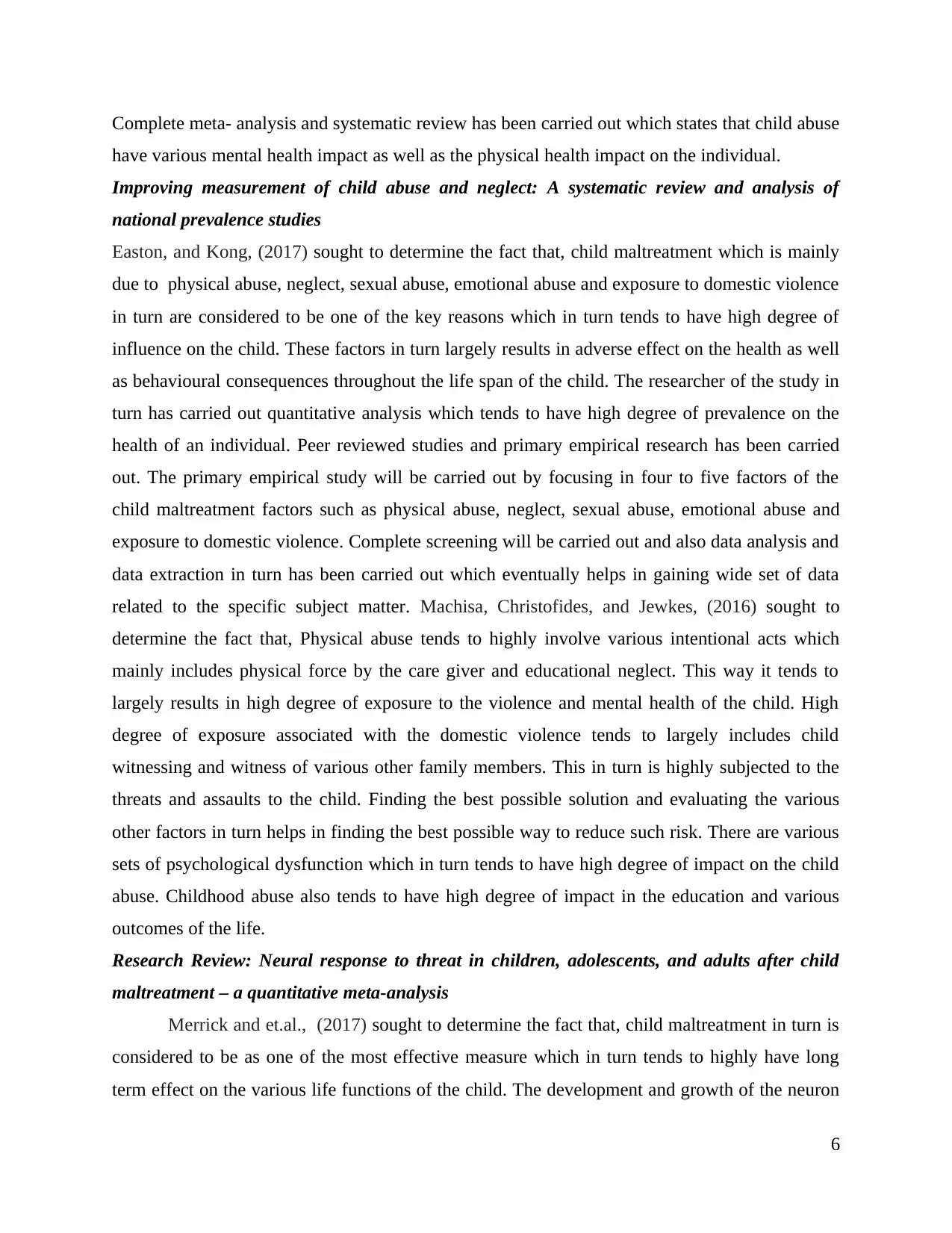
Complete meta- analysis and systematic review has been carried out which states that child abuse
have various mental health impact as well as the physical health impact on the individual.
Improving measurement of child abuse and neglect: A systematic review and analysis of
national prevalence studies
Easton, and Kong, (2017) sought to determine the fact that, child maltreatment which is mainly
due to physical abuse, neglect, sexual abuse, emotional abuse and exposure to domestic violence
in turn are considered to be one of the key reasons which in turn tends to have high degree of
influence on the child. These factors in turn largely results in adverse effect on the health as well
as behavioural consequences throughout the life span of the child. The researcher of the study in
turn has carried out quantitative analysis which tends to have high degree of prevalence on the
health of an individual. Peer reviewed studies and primary empirical research has been carried
out. The primary empirical study will be carried out by focusing in four to five factors of the
child maltreatment factors such as physical abuse, neglect, sexual abuse, emotional abuse and
exposure to domestic violence. Complete screening will be carried out and also data analysis and
data extraction in turn has been carried out which eventually helps in gaining wide set of data
related to the specific subject matter. Machisa, Christofides, and Jewkes, (2016) sought to
determine the fact that, Physical abuse tends to highly involve various intentional acts which
mainly includes physical force by the care giver and educational neglect. This way it tends to
largely results in high degree of exposure to the violence and mental health of the child. High
degree of exposure associated with the domestic violence tends to largely includes child
witnessing and witness of various other family members. This in turn is highly subjected to the
threats and assaults to the child. Finding the best possible solution and evaluating the various
other factors in turn helps in finding the best possible way to reduce such risk. There are various
sets of psychological dysfunction which in turn tends to have high degree of impact on the child
abuse. Childhood abuse also tends to have high degree of impact in the education and various
outcomes of the life.
Research Review: Neural response to threat in children, adolescents, and adults after child
maltreatment – a quantitative meta‐analysis
Merrick and et.al., (2017) sought to determine the fact that, child maltreatment in turn is
considered to be as one of the most effective measure which in turn tends to highly have long
term effect on the various life functions of the child. The development and growth of the neuron
6
have various mental health impact as well as the physical health impact on the individual.
Improving measurement of child abuse and neglect: A systematic review and analysis of
national prevalence studies
Easton, and Kong, (2017) sought to determine the fact that, child maltreatment which is mainly
due to physical abuse, neglect, sexual abuse, emotional abuse and exposure to domestic violence
in turn are considered to be one of the key reasons which in turn tends to have high degree of
influence on the child. These factors in turn largely results in adverse effect on the health as well
as behavioural consequences throughout the life span of the child. The researcher of the study in
turn has carried out quantitative analysis which tends to have high degree of prevalence on the
health of an individual. Peer reviewed studies and primary empirical research has been carried
out. The primary empirical study will be carried out by focusing in four to five factors of the
child maltreatment factors such as physical abuse, neglect, sexual abuse, emotional abuse and
exposure to domestic violence. Complete screening will be carried out and also data analysis and
data extraction in turn has been carried out which eventually helps in gaining wide set of data
related to the specific subject matter. Machisa, Christofides, and Jewkes, (2016) sought to
determine the fact that, Physical abuse tends to highly involve various intentional acts which
mainly includes physical force by the care giver and educational neglect. This way it tends to
largely results in high degree of exposure to the violence and mental health of the child. High
degree of exposure associated with the domestic violence tends to largely includes child
witnessing and witness of various other family members. This in turn is highly subjected to the
threats and assaults to the child. Finding the best possible solution and evaluating the various
other factors in turn helps in finding the best possible way to reduce such risk. There are various
sets of psychological dysfunction which in turn tends to have high degree of impact on the child
abuse. Childhood abuse also tends to have high degree of impact in the education and various
outcomes of the life.
Research Review: Neural response to threat in children, adolescents, and adults after child
maltreatment – a quantitative meta‐analysis
Merrick and et.al., (2017) sought to determine the fact that, child maltreatment in turn is
considered to be as one of the most effective measure which in turn tends to highly have long
term effect on the various life functions of the child. The development and growth of the neuron
6
⊘ This is a preview!⊘
Do you want full access?
Subscribe today to unlock all pages.

Trusted by 1+ million students worldwide
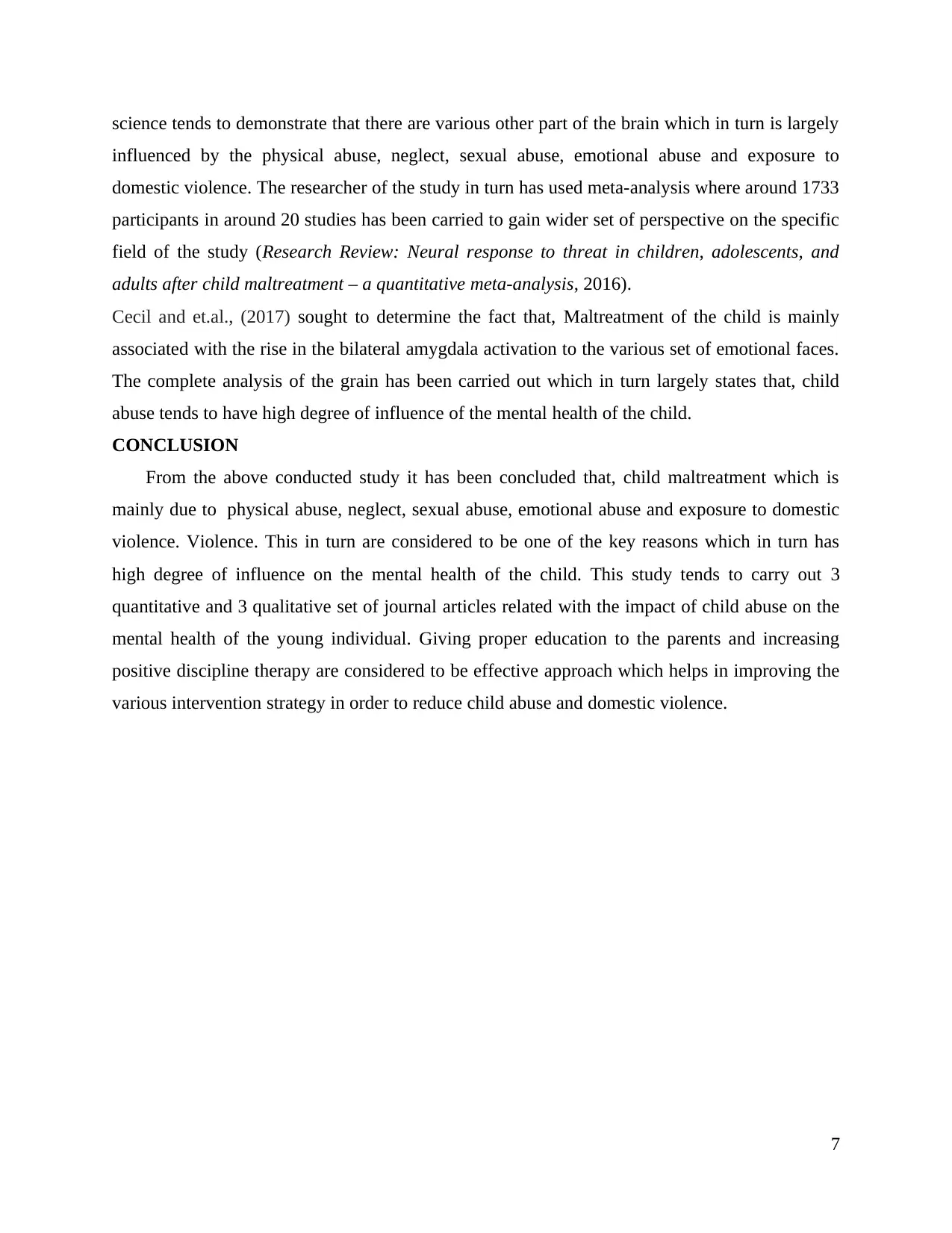
science tends to demonstrate that there are various other part of the brain which in turn is largely
influenced by the physical abuse, neglect, sexual abuse, emotional abuse and exposure to
domestic violence. The researcher of the study in turn has used meta-analysis where around 1733
participants in around 20 studies has been carried to gain wider set of perspective on the specific
field of the study (Research Review: Neural response to threat in children, adolescents, and
adults after child maltreatment – a quantitative meta‐analysis, 2016).
Cecil and et.al., (2017) sought to determine the fact that, Maltreatment of the child is mainly
associated with the rise in the bilateral amygdala activation to the various set of emotional faces.
The complete analysis of the grain has been carried out which in turn largely states that, child
abuse tends to have high degree of influence of the mental health of the child.
CONCLUSION
From the above conducted study it has been concluded that, child maltreatment which is
mainly due to physical abuse, neglect, sexual abuse, emotional abuse and exposure to domestic
violence. Violence. This in turn are considered to be one of the key reasons which in turn has
high degree of influence on the mental health of the child. This study tends to carry out 3
quantitative and 3 qualitative set of journal articles related with the impact of child abuse on the
mental health of the young individual. Giving proper education to the parents and increasing
positive discipline therapy are considered to be effective approach which helps in improving the
various intervention strategy in order to reduce child abuse and domestic violence.
7
influenced by the physical abuse, neglect, sexual abuse, emotional abuse and exposure to
domestic violence. The researcher of the study in turn has used meta-analysis where around 1733
participants in around 20 studies has been carried to gain wider set of perspective on the specific
field of the study (Research Review: Neural response to threat in children, adolescents, and
adults after child maltreatment – a quantitative meta‐analysis, 2016).
Cecil and et.al., (2017) sought to determine the fact that, Maltreatment of the child is mainly
associated with the rise in the bilateral amygdala activation to the various set of emotional faces.
The complete analysis of the grain has been carried out which in turn largely states that, child
abuse tends to have high degree of influence of the mental health of the child.
CONCLUSION
From the above conducted study it has been concluded that, child maltreatment which is
mainly due to physical abuse, neglect, sexual abuse, emotional abuse and exposure to domestic
violence. Violence. This in turn are considered to be one of the key reasons which in turn has
high degree of influence on the mental health of the child. This study tends to carry out 3
quantitative and 3 qualitative set of journal articles related with the impact of child abuse on the
mental health of the young individual. Giving proper education to the parents and increasing
positive discipline therapy are considered to be effective approach which helps in improving the
various intervention strategy in order to reduce child abuse and domestic violence.
7
Paraphrase This Document
Need a fresh take? Get an instant paraphrase of this document with our AI Paraphraser
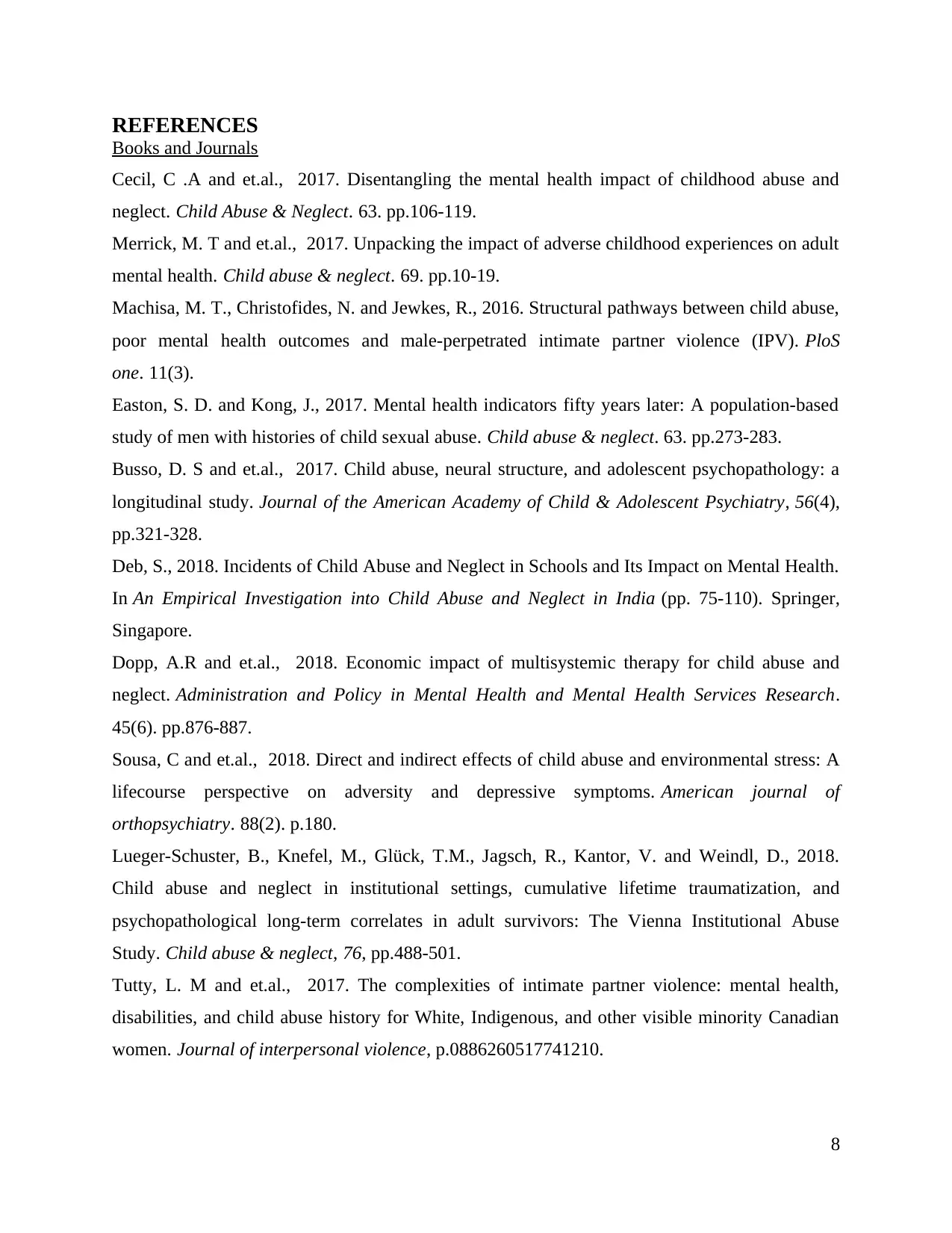
REFERENCES
Books and Journals
Cecil, C .A and et.al., 2017. Disentangling the mental health impact of childhood abuse and
neglect. Child Abuse & Neglect. 63. pp.106-119.
Merrick, M. T and et.al., 2017. Unpacking the impact of adverse childhood experiences on adult
mental health. Child abuse & neglect. 69. pp.10-19.
Machisa, M. T., Christofides, N. and Jewkes, R., 2016. Structural pathways between child abuse,
poor mental health outcomes and male-perpetrated intimate partner violence (IPV). PloS
one. 11(3).
Easton, S. D. and Kong, J., 2017. Mental health indicators fifty years later: A population-based
study of men with histories of child sexual abuse. Child abuse & neglect. 63. pp.273-283.
Busso, D. S and et.al., 2017. Child abuse, neural structure, and adolescent psychopathology: a
longitudinal study. Journal of the American Academy of Child & Adolescent Psychiatry, 56(4),
pp.321-328.
Deb, S., 2018. Incidents of Child Abuse and Neglect in Schools and Its Impact on Mental Health.
In An Empirical Investigation into Child Abuse and Neglect in India (pp. 75-110). Springer,
Singapore.
Dopp, A.R and et.al., 2018. Economic impact of multisystemic therapy for child abuse and
neglect. Administration and Policy in Mental Health and Mental Health Services Research.
45(6). pp.876-887.
Sousa, C and et.al., 2018. Direct and indirect effects of child abuse and environmental stress: A
lifecourse perspective on adversity and depressive symptoms. American journal of
orthopsychiatry. 88(2). p.180.
Lueger-Schuster, B., Knefel, M., Glück, T.M., Jagsch, R., Kantor, V. and Weindl, D., 2018.
Child abuse and neglect in institutional settings, cumulative lifetime traumatization, and
psychopathological long-term correlates in adult survivors: The Vienna Institutional Abuse
Study. Child abuse & neglect, 76, pp.488-501.
Tutty, L. M and et.al., 2017. The complexities of intimate partner violence: mental health,
disabilities, and child abuse history for White, Indigenous, and other visible minority Canadian
women. Journal of interpersonal violence, p.0886260517741210.
8
Books and Journals
Cecil, C .A and et.al., 2017. Disentangling the mental health impact of childhood abuse and
neglect. Child Abuse & Neglect. 63. pp.106-119.
Merrick, M. T and et.al., 2017. Unpacking the impact of adverse childhood experiences on adult
mental health. Child abuse & neglect. 69. pp.10-19.
Machisa, M. T., Christofides, N. and Jewkes, R., 2016. Structural pathways between child abuse,
poor mental health outcomes and male-perpetrated intimate partner violence (IPV). PloS
one. 11(3).
Easton, S. D. and Kong, J., 2017. Mental health indicators fifty years later: A population-based
study of men with histories of child sexual abuse. Child abuse & neglect. 63. pp.273-283.
Busso, D. S and et.al., 2017. Child abuse, neural structure, and adolescent psychopathology: a
longitudinal study. Journal of the American Academy of Child & Adolescent Psychiatry, 56(4),
pp.321-328.
Deb, S., 2018. Incidents of Child Abuse and Neglect in Schools and Its Impact on Mental Health.
In An Empirical Investigation into Child Abuse and Neglect in India (pp. 75-110). Springer,
Singapore.
Dopp, A.R and et.al., 2018. Economic impact of multisystemic therapy for child abuse and
neglect. Administration and Policy in Mental Health and Mental Health Services Research.
45(6). pp.876-887.
Sousa, C and et.al., 2018. Direct and indirect effects of child abuse and environmental stress: A
lifecourse perspective on adversity and depressive symptoms. American journal of
orthopsychiatry. 88(2). p.180.
Lueger-Schuster, B., Knefel, M., Glück, T.M., Jagsch, R., Kantor, V. and Weindl, D., 2018.
Child abuse and neglect in institutional settings, cumulative lifetime traumatization, and
psychopathological long-term correlates in adult survivors: The Vienna Institutional Abuse
Study. Child abuse & neglect, 76, pp.488-501.
Tutty, L. M and et.al., 2017. The complexities of intimate partner violence: mental health,
disabilities, and child abuse history for White, Indigenous, and other visible minority Canadian
women. Journal of interpersonal violence, p.0886260517741210.
8
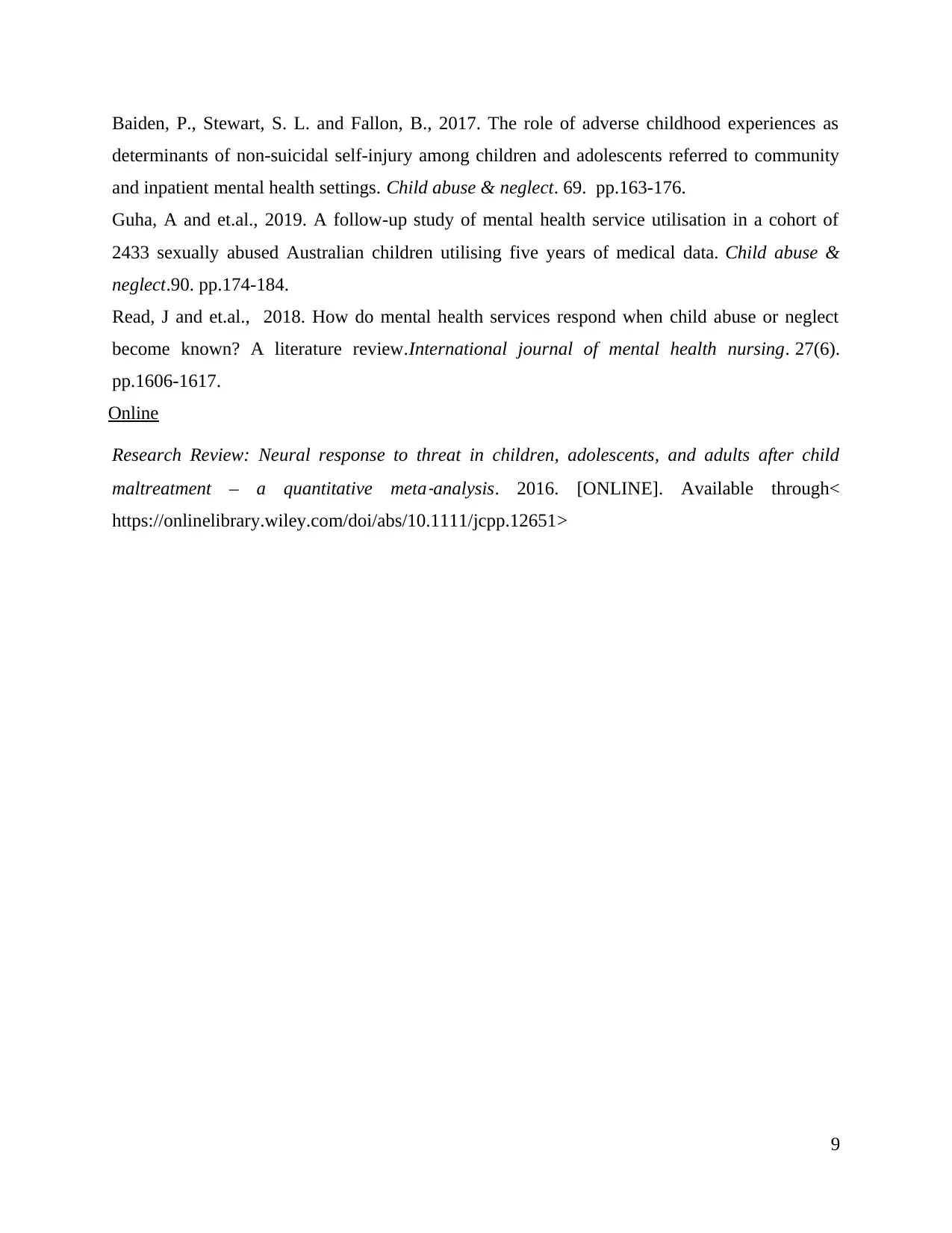
Baiden, P., Stewart, S. L. and Fallon, B., 2017. The role of adverse childhood experiences as
determinants of non-suicidal self-injury among children and adolescents referred to community
and inpatient mental health settings. Child abuse & neglect. 69. pp.163-176.
Guha, A and et.al., 2019. A follow-up study of mental health service utilisation in a cohort of
2433 sexually abused Australian children utilising five years of medical data. Child abuse &
neglect.90. pp.174-184.
Read, J and et.al., 2018. How do mental health services respond when child abuse or neglect
become known? A literature review.International journal of mental health nursing. 27(6).
pp.1606-1617.
Online
Research Review: Neural response to threat in children, adolescents, and adults after child
maltreatment – a quantitative meta
‐analysis. 2016. [ONLINE]. Available through<
https://onlinelibrary.wiley.com/doi/abs/10.1111/jcpp.12651>
9
determinants of non-suicidal self-injury among children and adolescents referred to community
and inpatient mental health settings. Child abuse & neglect. 69. pp.163-176.
Guha, A and et.al., 2019. A follow-up study of mental health service utilisation in a cohort of
2433 sexually abused Australian children utilising five years of medical data. Child abuse &
neglect.90. pp.174-184.
Read, J and et.al., 2018. How do mental health services respond when child abuse or neglect
become known? A literature review.International journal of mental health nursing. 27(6).
pp.1606-1617.
Online
Research Review: Neural response to threat in children, adolescents, and adults after child
maltreatment – a quantitative meta
‐analysis. 2016. [ONLINE]. Available through<
https://onlinelibrary.wiley.com/doi/abs/10.1111/jcpp.12651>
9
⊘ This is a preview!⊘
Do you want full access?
Subscribe today to unlock all pages.

Trusted by 1+ million students worldwide
1 out of 9
Related Documents
Your All-in-One AI-Powered Toolkit for Academic Success.
+13062052269
info@desklib.com
Available 24*7 on WhatsApp / Email
![[object Object]](/_next/static/media/star-bottom.7253800d.svg)
Unlock your academic potential
Copyright © 2020–2025 A2Z Services. All Rights Reserved. Developed and managed by ZUCOL.





